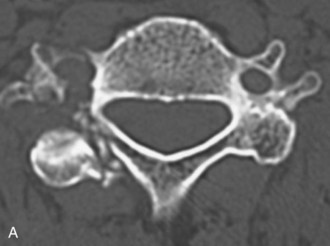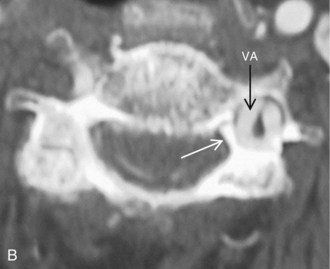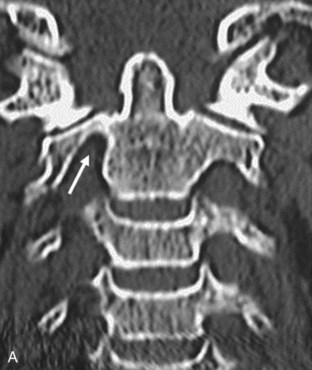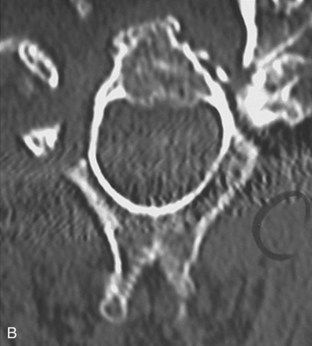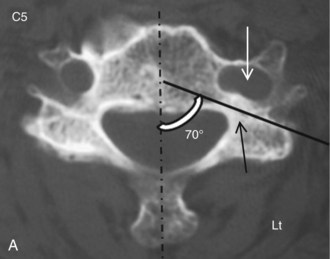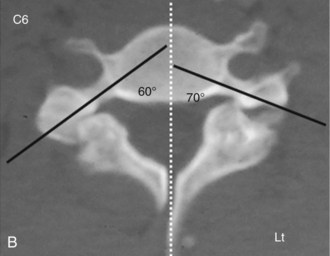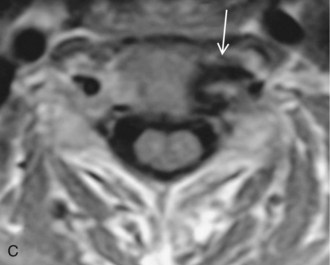Procedure 13 Cervical Pedicle Screw Fixation
Overview
 Despite increasing acceptance of the use of pedicle screws in the lumbar and thoracic spine, screw insertion into the cervical pedicle has been considered by spine surgeons to be too risky for the neurovascular structures, except at C2 and C7. Leconte first reported C2 pedicle screw insertion for osteosynthesis of the C2 hangman’s fracture. In the late 1980s, Goel and Laheri started to use C2 pedicle screws for atlantoaxial plate fixation in combination with C1 lateral mass screws. However, there had been no reports of pedicle screw fixation from C3 to C6 until the 1994 report by Abumi and colleagues of pedicle screw fixation for traumatic lesions of the lower cervical spine. Biomechanical studies revealed the superior stabilizing effect of pedicle screw fixation compared with other internal fixation procedures used with the cervical spine, including lateral mass screw fixation. In their recent experimental study, Johnston and colleagues revealed the superior pullout strength of a cervical pedicle screw versus a lateral mass screw after repetitive loading. Dunlop and colleagues demonstrated, by an in-vitro biomechanical study, that cervical pedicle screw/rod constructs support a greater axial load than lateral mass screw/rod constructs.
Despite increasing acceptance of the use of pedicle screws in the lumbar and thoracic spine, screw insertion into the cervical pedicle has been considered by spine surgeons to be too risky for the neurovascular structures, except at C2 and C7. Leconte first reported C2 pedicle screw insertion for osteosynthesis of the C2 hangman’s fracture. In the late 1980s, Goel and Laheri started to use C2 pedicle screws for atlantoaxial plate fixation in combination with C1 lateral mass screws. However, there had been no reports of pedicle screw fixation from C3 to C6 until the 1994 report by Abumi and colleagues of pedicle screw fixation for traumatic lesions of the lower cervical spine. Biomechanical studies revealed the superior stabilizing effect of pedicle screw fixation compared with other internal fixation procedures used with the cervical spine, including lateral mass screw fixation. In their recent experimental study, Johnston and colleagues revealed the superior pullout strength of a cervical pedicle screw versus a lateral mass screw after repetitive loading. Dunlop and colleagues demonstrated, by an in-vitro biomechanical study, that cervical pedicle screw/rod constructs support a greater axial load than lateral mass screw/rod constructs.
 The pedicle screw fixation procedure allows rigid fixation that provides the high correction capability needed to restore physiologic sagittal alignment of the cervical spine, as well as sufficient correction of malalignment in the occipitoatolantoaxial region. In addition, the pedicle screw fixation procedure, which does not require use of the lamina for stabilization, is quite valuable in patients who undergo one-stage posterior cervical decompression and stabilization, and in patients who undergo posterior reconstruction after previous posterior cervical decompression. On the other hand, the risks of neurovascular complications caused by inadequate screw placement into the cervical pedicle cannot be completely obviated. Thorough knowledge of local anatomy, sufficient preoperative radiologic examinations, and the application of established surgical techniques are essential for this procedure.
The pedicle screw fixation procedure allows rigid fixation that provides the high correction capability needed to restore physiologic sagittal alignment of the cervical spine, as well as sufficient correction of malalignment in the occipitoatolantoaxial region. In addition, the pedicle screw fixation procedure, which does not require use of the lamina for stabilization, is quite valuable in patients who undergo one-stage posterior cervical decompression and stabilization, and in patients who undergo posterior reconstruction after previous posterior cervical decompression. On the other hand, the risks of neurovascular complications caused by inadequate screw placement into the cervical pedicle cannot be completely obviated. Thorough knowledge of local anatomy, sufficient preoperative radiologic examinations, and the application of established surgical techniques are essential for this procedure.
Indications
 Almost all the pathologic conditions requiring posterior stabilization of the occipitocervical junction, cervical spine, or cervicothoracic junction.
Almost all the pathologic conditions requiring posterior stabilization of the occipitocervical junction, cervical spine, or cervicothoracic junction.
 Most middle and lower cervical injuries with posterior disruption, or anterior and posterior disruption without a severely disrupted anterior column, can be managed by posterior surgery using cervical pedicle screw fixation alone.
Most middle and lower cervical injuries with posterior disruption, or anterior and posterior disruption without a severely disrupted anterior column, can be managed by posterior surgery using cervical pedicle screw fixation alone.
 Cervical spinal instability caused by nontraumatic lesions, including metastatic tumor, rheumatoid arthritis, destructive spondyloarthropathy, cervical intervention for posterior decompression of the spinal cord or nerve root, and so forth, are well managed by this procedure.
Cervical spinal instability caused by nontraumatic lesions, including metastatic tumor, rheumatoid arthritis, destructive spondyloarthropathy, cervical intervention for posterior decompression of the spinal cord or nerve root, and so forth, are well managed by this procedure.
 Cervical kyphosis caused by many causes, including postlaminectomy and posttraumatic kyphosis, cervical spondylotic myelopathy associated with kyphosis, and so forth, can be corrected sufficiently by this procedure.
Cervical kyphosis caused by many causes, including postlaminectomy and posttraumatic kyphosis, cervical spondylotic myelopathy associated with kyphosis, and so forth, can be corrected sufficiently by this procedure.
 A degenerative cervical spine with segmental instability requiring posterior decompression also can be managed by simultaneous decompression and stabilization using pedicle screw fixation.
A degenerative cervical spine with segmental instability requiring posterior decompression also can be managed by simultaneous decompression and stabilization using pedicle screw fixation.
 This procedure is beneficial for stabilization of the unstable motion segment caused by extensive decompression of the nerve root or spinal cord, affecting stability of the facet joint.
This procedure is beneficial for stabilization of the unstable motion segment caused by extensive decompression of the nerve root or spinal cord, affecting stability of the facet joint.
 Salvage of pseudarthrosis of anterior fusion.
Salvage of pseudarthrosis of anterior fusion.
 Fusion-level elongation for adjacent segment degeneration after anterior or posterior fusion surgery.
Fusion-level elongation for adjacent segment degeneration after anterior or posterior fusion surgery.
Indications Pitfalls
• Infectious disorders at the posterior portion of the cervical spine are contraindications for pedicle screw fixation.
• Pedicles destroyed by injuries, tumors, rheumatoid arthritis
• Pedicles of the vertebra associated with major anomalies of the vertebral artery, and so forth, are inadequate and risky for screw insertion (Figures 13-1 and 13-2).
• Figure 13-1 shows an abnormal condition of the cervical pedicle. Pedicles destroyed by injuries, tumors, or marked osteoporosis; extremely small pedicles; pedicles of the vertebrae associated with major anomalies of the vertebral artery, and so forth, are inadequate and risky for screw insertion. Figure 13-1, A shows a fracture of the pedicle in a patient with a lateral mass fracture. Figure 13-2, B shows a pedicle of an extremely small size in a patient with rheumatoid arthritis.
• Figure 13-2 shows a small size of the pedicle of the axis. Figure 13-2, A shows that the diameter of right side of the pedicle of the axis is too small for screw insertion by high-riding vertebral artery bends into the lateral mass of the axis (arrow). Figure 13-2, B shows extremely small pedicles of the axis for screw insertion.
• Patients sometimes have extreme unilateral dominance of the vertebral artery. In this condition, the dominant-side foramen transversarium enlarges, and the ipsilateral side of the pedicle decreases in size (Figure 13-3). Retrogression of the pedicle is found on the side of the dominant vertebral artery. Figure 13-3, A shows that patients sometimes show extreme right-left dominance of the vertebral artery. Figure 13-3, B shows that the dominant side of the foramen transversarium enlarges and that the ipsilateral side of the pedicle decreases in size (white arrow).
• For the patient with unilateral obstruction of the vertebral artery by injury, tumor, congenital anomaly, and so forth, screw insertion on the preserved artery side must be conducted with great care, or screw insertion should only be performed on the obstructed side.
Examination/Imaging
 Preoperative oblique-projection plain radiograph films are valuable for evaluation of the pedicle size. In an oblique projection, the contralateral pedicle is seen as an oval projected onto the vertebral body, showing the outer and inner diameter of the pedicle. If the projection shows no inner diameter, the pedicle does not have a medullary canal.
Preoperative oblique-projection plain radiograph films are valuable for evaluation of the pedicle size. In an oblique projection, the contralateral pedicle is seen as an oval projected onto the vertebral body, showing the outer and inner diameter of the pedicle. If the projection shows no inner diameter, the pedicle does not have a medullary canal.
 Computerized tomography (CT) evaluations (adjusted to the bone windows) are essential to assess the pedicle morphometry and to determine pedicle size, which allows surgeons to choose the appropriate pedicle screw diameter, length, direction in the coronal plane, and screw insertion point. Reconstructive CT in the oblique plane provides useful information about the size of the neural foramen.
Computerized tomography (CT) evaluations (adjusted to the bone windows) are essential to assess the pedicle morphometry and to determine pedicle size, which allows surgeons to choose the appropriate pedicle screw diameter, length, direction in the coronal plane, and screw insertion point. Reconstructive CT in the oblique plane provides useful information about the size of the neural foramen.
 Preoperative evaluation of the morphology of the vertebral artery is important in preventing serious complications involving the artery.
Preoperative evaluation of the morphology of the vertebral artery is important in preventing serious complications involving the artery.
Surgical Anatomy
 According to previous studies by Panjabi and colleagues and by Karaikovic and colleagues, the pedicle of the cervical spine in a normal population has a sufficient diameter to allow insertion of a screw with a diameter of 3.5 mm or more.
According to previous studies by Panjabi and colleagues and by Karaikovic and colleagues, the pedicle of the cervical spine in a normal population has a sufficient diameter to allow insertion of a screw with a diameter of 3.5 mm or more.
 According to an anatomic study by Reinhold and colleagues, the average overall angle between the sagittal plane and the longitudinal pedicle axis was 46 degrees, varying from 30 degrees to 62 degrees. The smallest angle was at C7, the largest at C4. Their results were similar to previous studies by Karaikovic and colleagues.
According to an anatomic study by Reinhold and colleagues, the average overall angle between the sagittal plane and the longitudinal pedicle axis was 46 degrees, varying from 30 degrees to 62 degrees. The smallest angle was at C7, the largest at C4. Their results were similar to previous studies by Karaikovic and colleagues.
 Pedicle screw insertion into a vertebra with an extremely large angle between the pedicle axis and the sagittal plane may be possible but puts the vertebral artery and the spinal cord at risk. Figure 13-4 shows an extremely large angle between the pedicle axis and the sagittal plane. The left side of the foramen transversarium is enlarged toward the vertebral body (Figure 13-4, A, open arrow), and the angle between the pedicle axis (black line) and the sagittal plane is extremely large because of deformation of the foramen. In a case of C6 spondylolysis, the angle between the pedicle axis (Figure 13-4, B, black line) and the sagittal plane is extremely large. Screw insertion into the left side of the pedicle is too risky for the vertebral artery and the spinal cord.
Pedicle screw insertion into a vertebra with an extremely large angle between the pedicle axis and the sagittal plane may be possible but puts the vertebral artery and the spinal cord at risk. Figure 13-4 shows an extremely large angle between the pedicle axis and the sagittal plane. The left side of the foramen transversarium is enlarged toward the vertebral body (Figure 13-4, A, open arrow), and the angle between the pedicle axis (black line) and the sagittal plane is extremely large because of deformation of the foramen. In a case of C6 spondylolysis, the angle between the pedicle axis (Figure 13-4, B, black line) and the sagittal plane is extremely large. Screw insertion into the left side of the pedicle is too risky for the vertebral artery and the spinal cord.
 Karaikovic and colleagues defined the inner morphology of the cervical pedicles. They revealed that the thinnest pedicle cortex was always the lateral cortex, and some pedicles had no medullary canal (i.e., where solid cortical bone is expected: 0.9% for C2, 2.8% for C3 and C4, and 3.8% for C5 pedicles).
Karaikovic and colleagues defined the inner morphology of the cervical pedicles. They revealed that the thinnest pedicle cortex was always the lateral cortex, and some pedicles had no medullary canal (i.e., where solid cortical bone is expected: 0.9% for C2, 2.8% for C3 and C4, and 3.8% for C5 pedicles).
 The vertebral artery sometimes bends into the vertebral body forming the loop, and screw insertion into the ipsilateral side of the pedicle may put the artery at risk. Figure 13-5 shows loop formation of the vertebral artery.
The vertebral artery sometimes bends into the vertebral body forming the loop, and screw insertion into the ipsilateral side of the pedicle may put the artery at risk. Figure 13-5 shows loop formation of the vertebral artery.
 MRA shows the medial loop of the left vertebral artery (Figure 13-5, A, arrow).
MRA shows the medial loop of the left vertebral artery (Figure 13-5, A, arrow).
 CT (Figure 13-5, B) and MRI (Figure 13-5, C) images show that the vertebral artery bends into the vertebral body, forming the loop (arrows). Screw insertion into the left side of the pedicle is too risky for the artery.
CT (Figure 13-5, B) and MRI (Figure 13-5, C) images show that the vertebral artery bends into the vertebral body, forming the loop (arrows). Screw insertion into the left side of the pedicle is too risky for the artery.
Positioning
 The authors prefer to stand at the head of the patient, to ensure symmetric insertion of the right and left screws, while the assistant for a right-handed surgeon usually stands on the left side of the patient.
The authors prefer to stand at the head of the patient, to ensure symmetric insertion of the right and left screws, while the assistant for a right-handed surgeon usually stands on the left side of the patient.
 The C-arm display is placed on the left side of the patient near the patient’s pelvis for easy viewing by the surgeon. The authors’ preferred operation room setup for posterior cervical spinal procedures is shown in Figure 13-6.
The C-arm display is placed on the left side of the patient near the patient’s pelvis for easy viewing by the surgeon. The authors’ preferred operation room setup for posterior cervical spinal procedures is shown in Figure 13-6.

